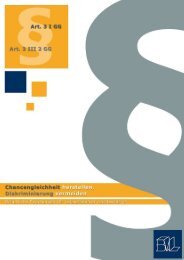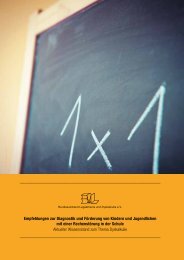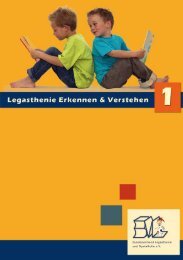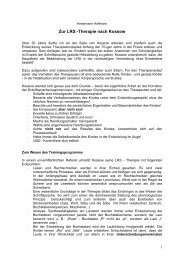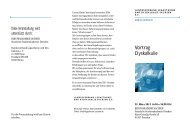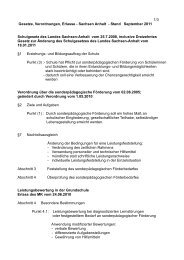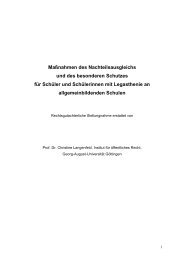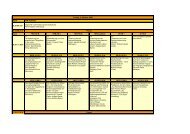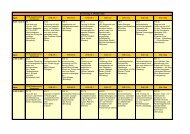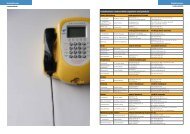Testverfah - Bundesverband Legasthenie und Dyskalkulie eV
Testverfah - Bundesverband Legasthenie und Dyskalkulie eV
Testverfah - Bundesverband Legasthenie und Dyskalkulie eV
Erfolgreiche ePaper selbst erstellen
Machen Sie aus Ihren PDF Publikationen ein blätterbares Flipbook mit unserer einzigartigen Google optimierten e-Paper Software.
15. Kongress des <strong>B<strong>und</strong>esverband</strong>es <strong>Legasthenie</strong> Abstractband<br />
- Spiele ermöglichen Erfolgserlebnisse, die die Persönlichkeit des Kindes stärken<br />
<strong>und</strong> die Lernfreude wieder beleben<br />
- Bei richtiger Auswahl der Spiele können erforderlich Lernvoraussetzungen wie z.<br />
B. Orientierungs- <strong>und</strong> Merkfähigkeit fachbezogen gefördert werden.<br />
Im Rahmen des Vortrags werden auf der Gr<strong>und</strong>lage kurzer theoretischer Überlegungen<br />
zur Bedeutung des Spiels am Beispiel von Materialien des Duden Paetec<br />
Instituts für Lerntherapie Möglichkeiten der spielerischen Lernförderung in Schule,<br />
Therapie <strong>und</strong> Elternhaus vorgestellt.<br />
- Erfolgreich lernen. Die besten Strategien für Ihr Kind.“ Köln: vgs-Verlagsgesellschaft<br />
2003<br />
- „10 Tipps, wie Sie Ihre Kinder zum Lesen verlocken…“. In: Leseinitiative NRW:<br />
Handbuch Leseförderung. Düsseldorf: Ministerium für Schule, Jugend <strong>und</strong> Kinder<br />
des Landes Nordrhein-Westfalen 2003, S. 24<br />
- „Medienerziehung einmal anders: SPIELend. Seminardokumentation.“ Stuttgart:<br />
Aktion Jugendschutz 1992<br />
- „Freizeit für Leseratten. Dokumentation.“ Hrsg. von Landesarbeitsgemeinschaft<br />
Jugend <strong>und</strong> Literatur Nordrhein-Westfalen e.V. Brauweiler: LAG Jugend <strong>und</strong> Literatur<br />
o. J.<br />
Korrespondenzautor:<br />
Birgit Ebbert<br />
ebbert@duden-paetec.de<br />
++49 0234 9789272<br />
++49 0234 9789349<br />
Brain Imaging Studies of Typical and Atypical Reading Acquisition<br />
*Guinevere Eden<br />
Georgetown University, Department of Pediatrics, Washington, Vereinigte Staaten von Amerika<br />
A better <strong>und</strong>erstanding of the functional anatomy of typical reading acquisition is<br />
essential to the development of successful instructional strategies for reading disabilities.<br />
Using functional MRI (fMRI to non-invasively visualize the neural basis<br />
of reading acquisition in children, we fo<strong>und</strong> that between the ages of 6 and 22<br />
years, learning to read is associated with both increased activity in left hemisphere<br />
middle temporal and inferior frontal gyri (Turkeltaub et al., 2003). In a case study of<br />
advanced hyperlexic reading we fo<strong>und</strong> that precocious reading is associated with<br />
hyper-activation of the left superior temporal cortex, much in the same way that<br />
dyslexia is associated with hypo-activation of this area (Turkeltaub et al., 2004).<br />
Finally, we investigated how these regions are modulated if adults with dyslexia<br />
acquire reading through intensive remediation later in life. A phonologically-targeted<br />
intervention resulted in improvements in phonological and reading skills in a<br />
tutored compared to non-tutored group of dyslexics. These gains were associated<br />
with increased activity in those left-hemisphere regions engaged by normal readers<br />
and compensatory activity in numerous regions of right perisylvian cortex. Hence,<br />
behavioral plasticity in adult developmental dyslexia involves two distinct neural<br />
mechanisms; each of these has previously been observed either for remediation of<br />
developmental or of acquired reading disorders (Eden et al., 2004). Overall these<br />
23



